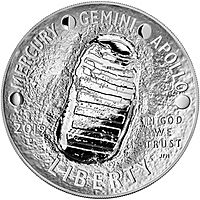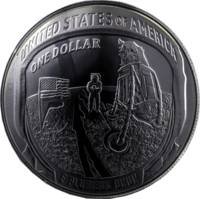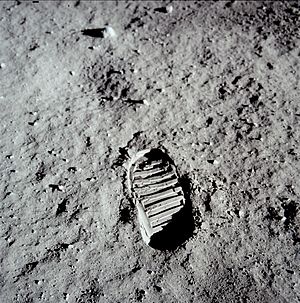Apollo 11 50th Anniversary commemorative coins facts for kids
The Apollo 11 50th Anniversary commemorative coins were special coins made by the United States Mint in 2019. They were created to celebrate the 50th anniversary of the first time humans landed on the Moon. This amazing event happened thanks to Apollo 11 astronauts Neil Armstrong and Buzz Aldrin.
These coins came in different types:
- A gold coin worth $5 (called a half eagle).
- Two different sizes of silver dollars.
- A half dollar coin made of copper and nickel.
Most of these coins were made in two styles: "proof" (meaning they have a shiny, mirror-like finish) and "uncirculated" (meaning they are new but not as shiny). The larger silver dollar was only made in the proof style. The gold coins were made in West Point, New York. The silver coins were made in Philadelphia, Pennsylvania. The copper-nickel half dollars were made in Denver, Colorado, and San Francisco, California.
All four types of coins share the same design. The front side, called the obverse, shows a bootprint on the Moon's surface. This design was inspired by a real photograph taken by Buzz Aldrin. A sculptor named Gary Cooper created this design. The back side, called the reverse, shows the helmet and visor of Buzz Aldrin's space suit. You can see reflections in the visor, including Neil Armstrong, the U.S. Flag, and the Apollo Lunar Module Eagle. This design was based on a famous photo taken by Armstrong. Phebe Hemphill from the Mint created this design. Buzz Aldrin was still alive when these coins were made. This made him one of only seven people to appear on a U.S. coin while still living.
These Apollo 11 coins are special because they are curved. The front side is shaped like a bowl (concave), and the back side is shaped like a dome (convex). Before they were released, many people thought they would sell out very quickly. This had happened with other curved U.S. coins before. However, these Apollo 11 coins did not sell out before sales ended in December 2019. Still, they were very popular! Over 600,000 Apollo 11 coins were sold. This made it the most successful special coin program since the 2014 Baseball Hall of Fame coins. The larger silver dollar even won the "Coin of the Year Award" for coins made in 2019.
Contents
The Story Behind the Coins
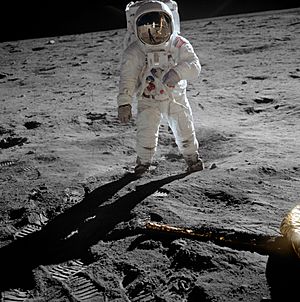
In 1961, U.S. President John F. Kennedy gave a big challenge to the nation. He wanted an American astronaut to land on the Moon and return safely to Earth before 1970. NASA, the U.S. space agency, worked hard to achieve this goal. They sent astronauts into space with Project Mercury and Project Gemini. These missions led up to the Apollo program.
NASA reached its goal with Apollo 11. The spacecraft landed on the Moon on July 20, 1969. Neil Armstrong and Buzz Aldrin walked on the Moon's surface. Meanwhile, Michael Collins orbited the Moon in the command module. The mission returned to Earth safely on July 24, 1969. This completed President Kennedy's challenge.
About an hour and a half after Armstrong stepped onto the Moon, Aldrin did an experiment. He photographed an untouched area of the Moon's surface. Then, he made two bootprints and took pictures of them. These bootprints were not disturbed by the astronauts' later activities. You can still see them in photos taken from the Lunar Module Eagle before it left the Moon.
Later, Aldrin was supposed to photograph a spot where Armstrong had collected Moon rocks. Instead, Aldrin gave the camera to Armstrong. Armstrong took eight photos. One of these photos became very famous. It's a picture of Aldrin with his gold visor reflecting Armstrong, the Lunar Module, the flag, and the dark sky.
How the Coins Were Proposed
The idea for the Apollo 11 coins came from Mike Olson. He was part of a group that advises the government on coins. He thought of the idea in 2014 after watching the movie Apollo 13. He felt there should be a coin to celebrate the 50th anniversary of the Moon landing.
Mike Olson convinced his group to suggest the Apollo 11 coins in their yearly report. Later, he talked to a politician named Rod Blum. Blum then connected him with Bill Posey from Florida. Posey's area included the Kennedy Space Center. He had even worked on the Apollo program when he was younger.
Posey gathered support from other politicians. He introduced a bill in June 2015 to create the coins. In the past, similar bills for Moon landing anniversaries had not passed. The U.S. Mint had honored Moon landings before on other coins. For example, the back of the Eisenhower dollar (1971) and Susan B. Anthony dollar (1979) showed the Apollo 11 mission patch. The 2002 Ohio state quarter also showed an Apollo astronaut.
The bill for the Apollo 11 coins moved slowly at first. But supporters kept working hard. By November 2016, it had enough support in the House of Representatives. Mike Olson and foundations like the Astronauts Memorial Foundation also lobbied for the bill. Even Buzz Aldrin and Michael Collins supported it.
On December 5, 2016, the bill was debated in the House. Congressman Posey spoke about the history of Apollo 11. Other politicians spoke about the hundreds of thousands of workers who made Apollo possible. They hoped the coins would inspire young people to study science. The bill passed easily in the House.
Then, the bill went to the Senate. More senators supported it, and it passed there too on December 9. Finally, President Barack Obama signed the bill into law on December 16, 2016. It was one of the last bills he signed as president.
The new law said the coins should celebrate the 50th anniversary of the Moon landing. They had to be curved, like the popular 2014 Baseball Hall of Fame coins. Those coins had a concave (bowl-shaped) front side that looked like a baseball glove.
The law allowed for:
- Up to 50,000 gold $5 coins.
- 400,000 regular-sized silver dollars.
- 750,000 copper-nickel half dollars.
- 100,000 larger silver dollars (five troy ounces of silver and three inches wide).
All coins would have the same design. They would be available in both "uncirculated" and "proof" styles. The five-ounce silver dollar would only be in proof. The design for the curved front side would be chosen through a competition.
A small extra fee, called a surcharge, would be added to the price of each coin. This money would go to good causes. Half would go to the Smithsonian Institution's National Air and Space Museum for its "Destination: Moon" exhibit. The rest would be split between the Astronauts Memorial Foundation and the Astronaut Scholarship Foundation. These coins could only be sold during 2019.
Coin Design
Choosing the Design
The U.S. Mint held a competition to choose the design for the front side of the coins. People could send in their ideas from May to June 2017. The design could not show any living person, not even an astronaut. It had to represent the U.S. space program leading up to the first Moon landing.
A total of 119 designs were sent in. A special jury, made up of members from two art and coinage committees, narrowed them down to 18 finalists. When the committees met, some members were not very excited about the designs. But they had to choose one.
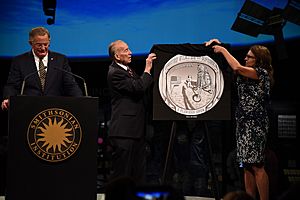
From the finalists, a design by sculptor Gary Cooper was chosen. It showed an astronaut's bootprint on the Moon. Cooper had always been interested in coins. He said, "I remember seeing those first footprints, and it made so many people feel like that was their own footprint." Mint artists helped turn Cooper's idea into a design that could be put on a coin. Joseph F. Menna, a Mint engraver, adapted the design.
For the back side of the coin, artists at the Mint created three designs. Both committees agreed on one design in June 2017. This design was made and engraved by Phebe Hemphill, a Mint sculptor-engraver.
The winning designs were shown to the public on October 11, 2018. This happened at the National Air and Space Museum in Washington, D.C. Important people, like Mint Director David J. Ryder and Apollo 7 astronaut Walt Cunningham, were there. At the event, Ryder even guessed that the five-ounce silver dollars might sell out in just ten minutes!
What the Designs Show
The front side of the coins, designed by Gary Cooper, shows an astronaut's bootprint. This famous image was taken by Buzz Aldrin with a special camera. It represents the very first step on the Moon. Cooper said he had to be creative because the original photo had dark shadows in the bootprint.
Around the edge of the coin are the words "MERCURY," "GEMINI," and "APOLLO." These are the names of the NASA space programs that led to the Moon landing. Small pictures of the Moon's phases (how it looks from Earth) are shown between these words. They go from a crescent moon to a full moon, showing progress towards the landing. At the bottom are the words "LIBERTY" and "IN GOD WE TRUST," along with the year 2019.
Congress specifically asked for the back side of the coin to show a close-up of Buzz Aldrin's helmet and visor. This was based on a famous photo from July 20, 1969. The visor has a shiny, mirrored surface. In the reflection, you can see the United States flag, the lunar lander, and Neil Armstrong (the photographer). The rest of the helmet has a dull, frosted look.
It's not common for a living person to be on a U.S. coin. But Congress made an exception for Buzz Aldrin. This made him the seventh person to be shown on a U.S. coin while still alive.
The back side of the coin is curved outwards (convex). This shape is meant to look like the curve of an astronaut's helmet visor. Phebe Hemphill, the designer, said she made the curve extra strong to create this effect. Around the visor are the words "UNITED STATES OF AMERICA" and "E PLURIBUS UNUM." The coin's value is also shown.
Making the Coins
On December 13, 2018, the first silver dollars were officially made at the Philadelphia Mint. The children of the Apollo 11 astronauts – Mark Armstrong, Andy Aldrin, and Ann Collins – helped strike the first coins. Mint Director Ryder also struck a five-ounce coin. He believed all the coins would sell out. If they did, it would raise $14.5 million for the charities.
The Mint had some challenges making the curved coins. They had to figure out the right angle to strike them so they would be perfect. They started with the five-ounce dollar and then used what they learned for the smaller coins. Each coin die (the tool that stamps the design) was made using special equipment and then finished by hand.
Early attempts had problems, like cracks appearing on the lunar lander's legs or issues with the metal flow. They solved these by making adjustments and switching from 90% silver to 99.9% pure silver. The two Apollo 11 silver dollars were the first U.S. special coins made with 99.9% silver. This change allowed the U.S. Mint to use the same high-purity silver as other mints around the world.
The large three-inch silver dollar was made on a special press at the Philadelphia Mint. This press was also used for the America the Beautiful three-inch quarters. It took about 11.5 hours to make each die for the five-ounce silver dollar. Each die could stamp about 100 coins.
Before sales began on January 24, 2019, many people thought the coins would sell out quickly. This had happened with the 2014 Baseball Hall of Fame coins. Those gold coins sold out in minutes, and the silver dollars were gone in less than two weeks.
On January 18, the prices for the non-gold coins were announced. The five-ounce silver dollar cost $224.95. Each household could buy only one at first. The smaller silver dollar cost $54.95 for the proof coin and $51.95 for the uncirculated coin. Households could buy up to 100 of these. The half dollar coins were $25.95 (uncirculated) and $27.95 (proof). There was no limit on how many half dollars you could buy.
There was also a special set with an Apollo 11 half dollar and a 2019–S Kennedy half dollar. This set cost $53.95 and was limited to 100,000 sets. It was made to show the link between President Kennedy and the space program. Prices for the gold coins were set closer to the sale date. They were $418.50 for the proof gold coin and $408.50 for the uncirculated one. Each household could buy only one gold coin at first.
Selling the Coins
Release Day
A special event was held at the Kennedy Space Center Visitor Complex on January 24, 2019, to celebrate the release of the coins. Charles Duke, who was a flight controller during the Apollo 11 landing, spoke at the ceremony. He said the new coins would bring back memories of that historic day. He also praised the coins for raising money for good causes.
The Apollo 11 coins went on sale to the public on January 24, 2019. People could buy them online, by phone, at Mint sales centers, and at the Kennedy Space Center event. Collectors said it was easy to order online. Even though the three-inch silver dollar went into "backorder" status quickly, none of the coins sold out on the first day.
Some people were surprised that the coins didn't sell out immediately. But Mike Olson, who first thought of the coins, was happy. He believed they would all sell out by the end of the year.
In the first 24 hours, 296,311 Apollo 11 coins were sold. The five-ounce silver dollar was the most popular, with over 51,000 sold. The next day, the Mint removed the limit on how many coins a single household could buy.
Continued Sales

On January 29, the Mint announced a small mistake. The packaging for 70,000 half dollar sets had a factual error. It wrongly said that one person designed both sides of the Kennedy half dollar. In fact, two different people designed them. The Mint stopped shipping these sets and planned to print new packaging. They later sent replacement sleeves to customers who had bought the sets.
By February 10, almost all of the special half dollar sets had sold out. But the Apollo 11 half dollar itself was still available. On February 25, the special introductory prices ended, and coin prices went up by $5.
Mint Director Ryder had promised to send some of the coins into space. This happened on May 4, 2019. Two proof half dollars were launched into space aboard a SpaceX Dragon spacecraft. They went to the International Space Station. They returned to Earth on June 3. One of these "flown" coins would be part of the "Destination: Moon" exhibit at the Smithsonian. The other would be displayed at Mint headquarters.
The U.S. Mint also worked with other countries' mints. On May 6, the Royal Australian Mint (RAM) sold a set. It included a U.S. Apollo 11 half dollar and a curved Australian $5 coin. Only 10,000 of these sets were made. The U.S. Mint also partnered with Spain's Royal Mint and the Royal Canadian Mint for special coin sets.

By June 30, many coins had been sold. The 50th anniversary of the Moon landing in July boosted sales even more. Four of the Mint's top ten best-selling items for the week ending July 21 were Apollo 11 coins.
In August, the Mint started selling new sets. These sets included either a $5 gold coin or a smaller silver dollar, along with a special print from the Bureau of Engraving and Printing. These new sets were very popular and quickly went into backorder status.
By September 29, sales continued to be strong across all coin types. Mint Director Ryder predicted that 90,000 of the five-ounce silver dollars would be sold.
Sales End
The Mint stopped reporting weekly sales figures after November 3, 2019. The last update before sales ended was for December 16. It showed that many coins had been sold. The Apollo 11 coins, along with other special coins from 2019, went off sale on December 27, 2019.
The Apollo 11 coins sold much better than other commemorative coins released in 2019. Coin experts noted that the Apollo 11 program was the most successful special coin program since 2014. They believed the Moon landing event touched many people's hearts. This meant many buyers were not just coin collectors.
In February 2021, the larger silver dollar won two awards: "Best Silver Coin" and "Best Contemporary Event Coin." On March 1, 2021, it was announced that the Apollo 11 coin won the overall "Coin of the Year Award" for 2019-dated coins.
Summary of Sales
Here's a summary of how many coins were sold, according to the Mint's report from February 14, 2021:
| Sales option | Initial price | Mint and mint mark | Authorized mintage | Total sales | Notes |
|---|---|---|---|---|---|
| $5 in proof condition | $418.50 | West Point (W) | 50,000 | 32,862 | |
| $5 proof with print | $504.00 (price of gold piece plus $19.00) | 1,162 | On sale August 7, 2019 | ||
| $5 uncirculated | $408.75 | 12,035 | 46,059 total $5 pieces sold | ||
| $1 (larger) | $224.95 | Philadelphia (P) | 100,000 | 68,301 | |
| $1 (smaller) proof | $54.95 | 400,000 | 218,995 | ||
| $1 (smaller) proof with print | $78.95 | 4.890 | On sale August 7, 2019 | ||
| $1 (smaller) uncirculated | $51.95 | 59,700 | 283,585 total smaller silver dollars sold | ||
| $.50 in proof | $27.95 | San Francisco (S) | 750,000 | 66,301 | |
| $.50 proof with 2019–S Kennedy half dollar | $53.95 | 99,998 | Limited to 100,000 sets. Sold out by February 21, 2019. | ||
| $.50 uncirculated | $25.95 | Denver (D) | 41,742 | 208,041 half dollars sold |
All coins went on sale January 24, 2019, and sales ended after December 27, 2019, unless noted otherwise. Prices went up by $5 on February 25 for most coins. The prices for the $5 gold coins changed based on the market price of gold.
See also
 In Spanish: Monedas conmemorativas del 50.º aniversario del Apolo 11 para niños
In Spanish: Monedas conmemorativas del 50.º aniversario del Apolo 11 para niños
- Apollo 11 in popular culture


